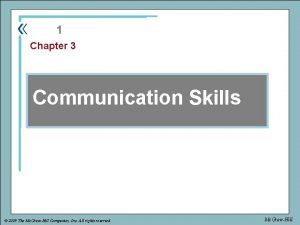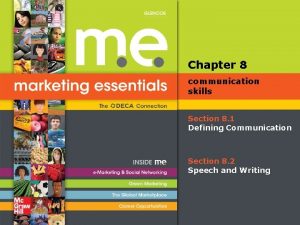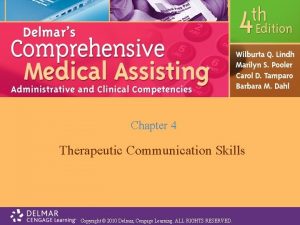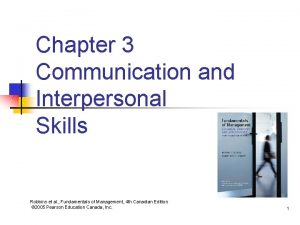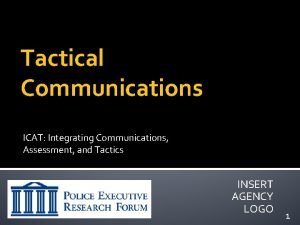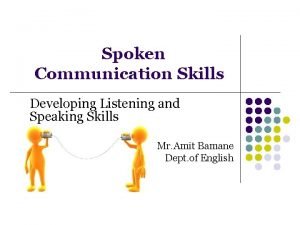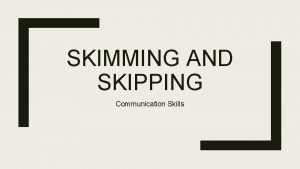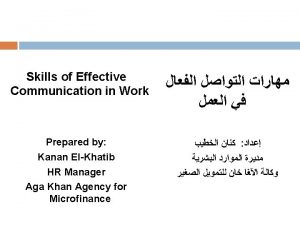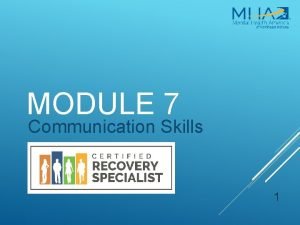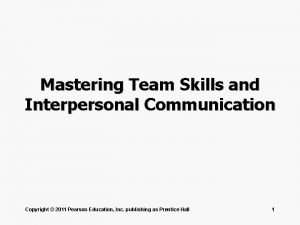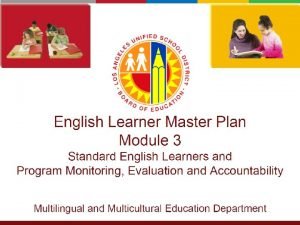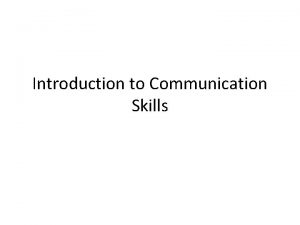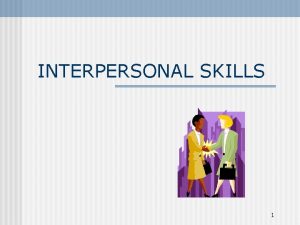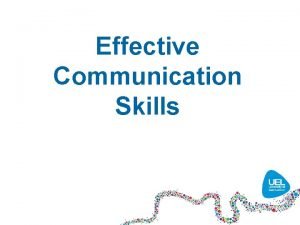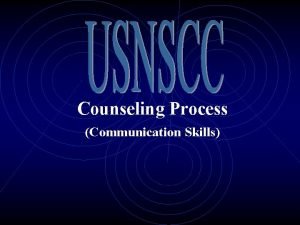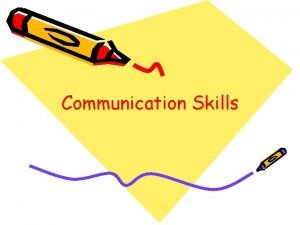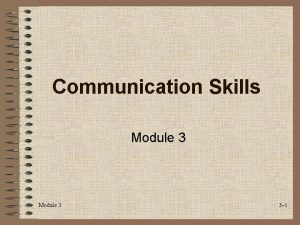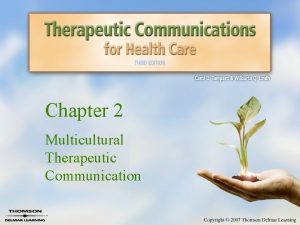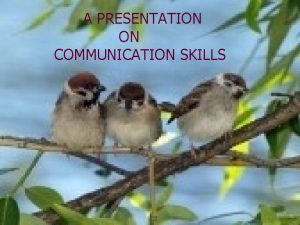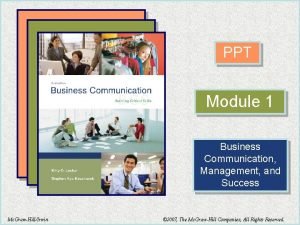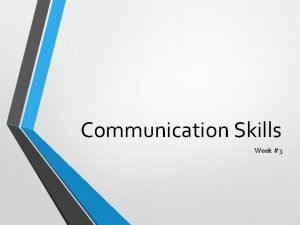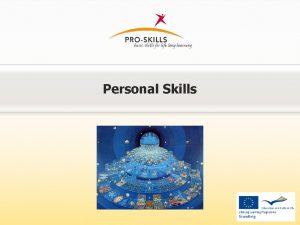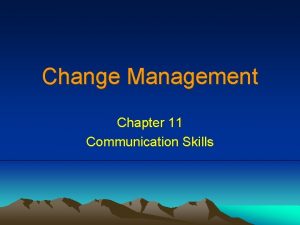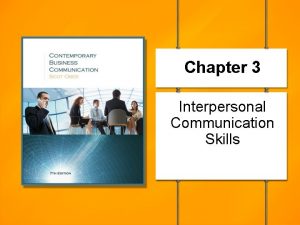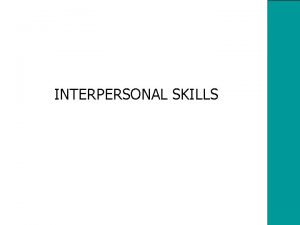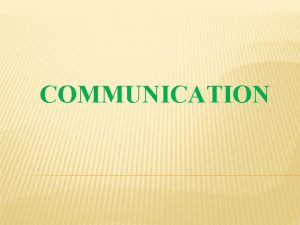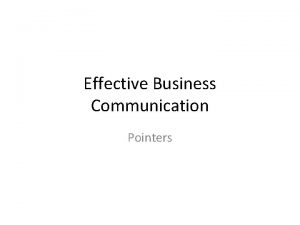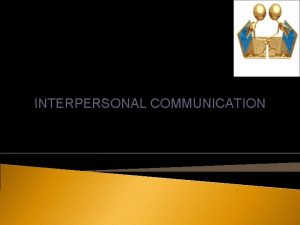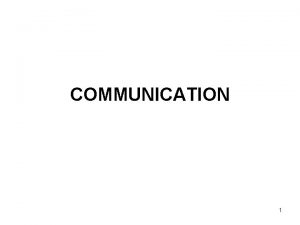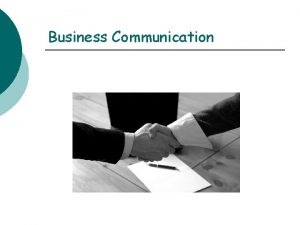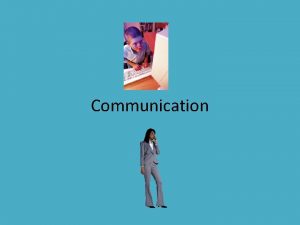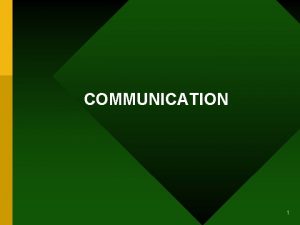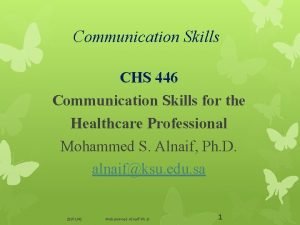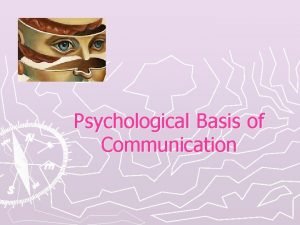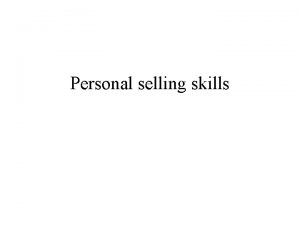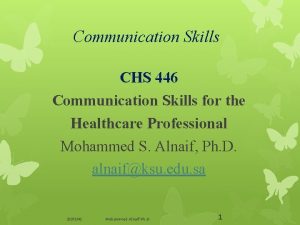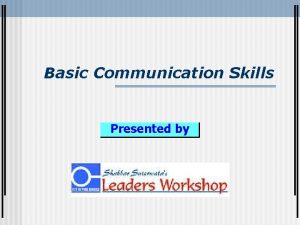Chapter 5 Communication Skills Communication Skills Definition of





































- Slides: 37

Chapter 5: Communication Skills

Communication Skills Definition of Communication Skills: The ability to convey information to another effectively and efficiently. Business managers with good verbal, non verbal and written communication skills help facilitate the sharing of information between people within a company for its commercial benefit.

Definition of Effective Communication Skills • Effective communication is a process through which the sender conveys a message that the receiver readily receives and understands. • It is a two-way process instead of a one-way process.

Effective Family Communication • Effective communication is an important characteristic of strong, healthy families. • Research identifies communication as an essential building block of strong marital, parent-child, and sibling relationships.

Family Communication • Family communication refers to the way verbal and non-verbal information is exchanged between family members. • Communication involves the ability to pay attention to what others are thinking and feeling. • An important part of communication is not just talking, but listening to what others have to say.

Cont------- • Communication within the family is extremely important because it enables members to express their needs, wants, and concerns to each other. • Open and honest communication creates an atmosphere that allows family members to express their differences as well as love and admiration for one another. • It is through communication that family members are able to resolve the unavoidable problems that arise in all families.

Cont------- • Just as effective communication is almost always found in strong, healthy families, poor communication is usually found in unhealthy family relationships. • Marriage and family therapists often report that poor communication is a common complaint of families who are having difficulties. • Poor communication is unclear and indirect. It can lead to numerous family problems, including excessive family conflict, ineffective problem solving, lack of intimacy, and weak emotional bonding.

Instrumental and Affective Communication • Communication can be divided into two different areas: instrumental and affective. • Instrumental communication is the exchange of factual information that enables individuals to fulfill common family functions (e. g. , telling a child that he/she will be picked up from school at a specific time and location). • Affective communication is the way individual family members share their emotions with one another (e. g. , sadness, anger, joy).

Cont------- • Some families function extremely well with instrumental communication, yet have great difficulty with affective communication. • Healthy families are able to communicate well in both areas. • Affective communication refers to how individual family members share their emotions with one another.

Clear vs. Masked and Direct vs. Indirect Communication • Communication can be clear or masked and direct or indirect. Clear communication occurs when messages are spoken plainly and the content is easily understood by other family members. • Masked communication occurs when the message is muddied or vague. • Communication is direct if the person spoken to is the person for whom the message is intended. Communication is indirect if the message is not directed to the person for whom it is intended.

Four Styles of Communication 1. Clear and Direct Communication: • Clear and direct communication is the most healthy form of communication and occurs when the message is stated plainly and directly to the appropriate family member. An example of this style of communication is when a father, disappointed about his son failing to complete his chore, states, "Son, I'm disappointed that you forgot to take out the trash today without my having to remind you. "

Cont----2. Clear and Indirect Communication: • In this second style of communication, the message is clear, but it is not directed to the person for whom it is intended. Using the previous example, the father might say, "It's disappointing when people forget to complete their chores. " In this message the son may not know that his father is referring to him.

Cont-----3. Masked and Direct Communication: • Masked and direct communication occurs when the content of the message is unclear, but directed to the appropriate family member. The father in our example may something like, "Son, people just don't work as hard as they used to. "

Cont----4. Masked and Indirect Communication: • Masked and indirect communication occurs when both the message and intended recipient are unclear. In unhealthy family relationships, communication tends to be very masked and indirect. An example of this type of communication might be the father stating, "The youth of today are very lazy. "

Keys to Building Effective Family Communication • There are many things that families can do to become more effective communicators and in turn to improve the quality of their relationships. • Families can improve their communication skills by following some suggestions for building effective family communication.

Cont---- • Communicate Frequently One of the most difficult challenges facing families today is finding time to spend together. It was stated that lack of time was a greater problem for family than lack of money.

Cont------- • With our busy schedules, it is difficult to find sufficient time to spend with one another in meaningful conversation. It is extremely important for families to make time to communicate. Talk in the car; turn the TV off and eat dinner together; schedule informal or formal family meetings to talk about important issues that affect your family; and talk to your children at bedtime.

Cont------ • Communicate Clearly and Directly Healthy families communicate their thoughts and feelings in a clear and direct manner. This is especially important when attempting to resolve problems that arise between family members (e. g. , spouse, parent-child). Indirect and vague communication will not only fail to resolve problems, but will also contribute to a lack of intimacy and emotional bonding between family members.

Cont----- • Be An Active Listener An essential aspect of effective communication is listening to what others are saying. Being an active listener involves trying your best to understand the point of view of the other person. Whether you are listening to a spouse or a child, it is important to pay close attention to their verbal and non-verbal messages.

Cont------- • As an active listener, you must acknowledge and respect the other person's perspective. For example, when listening to a spouse or child, you should nod your head or say, "I understand, " which conveys to the other person that you care about what he or she has to say. Another aspect of active listening is seeking clarification if you do not understand the other family member. This can be done by simply asking, "What did you mean when you said. . ? " or "Did you think I understand you correctly? "

Cont---- • In order for effective communication to take place within families, individual family members must be open and honest with one another. This openness and honesty will set the stage for trusting relationships. Without trust, families cannot build strong relationships. Parents, especially, are responsible for providing a safe environment that allows family members to openly express their thoughts and feelings.

Cont---- • Think About the Person With Whom You Are Communicating Not all family members communicate in the same manner or at the same level. This is especially true of young children. When communicating with young children, it is important for adults to listen carefully to what the children are saying without making unwarranted assumptions.

Cont----It is also important to take into consideration the ages and maturity levels of children. Parents cannot communicate with children in the same way that they communicate with their spouse because the child may not be old enough to understand

Cont------- • Pay Attention to Non-Verbal Messages In addition to carefully listening to what is being said, effective communicators also pay close attention to the non-verbal behaviors of other family members. For example, a spouse or child may something verbally, but their facial expressions or body language may be telling you something completely different. In cases such as these, it is important to find out how the person is really feeling.

Cont------- • Be Positive While it is often necessary to address problems between family members, or to deal with negative situations, effective communication is primarily positive. Marital and family researchers have discovered that unhappy family relationships are often the result of negative communication patterns (e. g. , criticism, contempt, defensiveness).

Cont-------Researchers have found that satisfied married couples had five positive interactions to every one negative interaction. Couples who are very dissatisfied with their relationships typically engage in more negative interactions than positive. It is very important for family members to verbally compliment/kind word and encourage one another.

Focus on Family Strengths Communication is a key to successful family functioning. Researchers agree that clear, open, and frequent communication is a basic characteristic of a strong, healthy family. Families that communicate in healthy ways are more capable of problem-solving and tend to be more satisfied with their relationships.

12 Tips from the Sunnah to Communicate Effectively with Others • 1. Smile: The Prophet said: • “Your smiling in the face of your brother is charity. ” [Jami` at-Tirmidhi] Before you start talking, smile! This is an instant ingredient to start any conversation positively and to remove any past ill feelings that could be present. • Smiling brings joy to the giver and the receiver.

Cont----- • 2. Pay attention to the tone and volume: Beware of your tone and the volume of your voice. Your tone determines whether you will make your relationship or break it. Any undesirable loudness in your voice could put people off and make any further attempts to communicate futile/useless. • “And be moderate in your pace and lower your voice; indeed, the most disagreeable of sounds is the voice of donkeys

Cont----- • 3. Start with the Islamic greeting of peace: Whether you know this Muslim or not, the greeting of peace or saying ‘Assalaamu alaykum’ (peace be upon you) is recommended. It will repel hatred and create love between you.

Cont----- • 4. Shake hands: Accompany your greeting with shaking hands (if you are greeting your mahram or a person of your gender). • “There are no two Muslims who meet and shake hands, but they will be forgiven before they part. ” [Sunan Ibn Majah]

Cont----- • 5. Inquire about people: Ask them how they are doing and inquire about their health and well-being and that of their family and friends. They will feel loved and cared for. • 6. Remember not all are the same: Consider people’s different characteristics and differences while communicating. Keep in mind their age, status, temperament and other factors.

Cont----- • 7. Teach at every opportunity: The Prophet used every chance to enjoin the good and forbid the evil. If there is ever a need for you to say something corrective in nature, do so gently. • 8. Refrain from the common evils of the tongue: People getting together and communicating with each other often leads to falling into various sins related to the tongue

Cont-----such as talking about Allah without knowledge, slandering, lying, insulting and cursing. These habits are grievous sins that eat away at our rewards and the barakahin our lives: make it a habit to ensure whether anything you are about to say may constitute any of these sins.

Cont----- • 9. Choose simple, concise words: Avoid complex language and sophisticated terminologies. Instead, try to stick to concise words and phrases that are of eloquence and seek to be understood. • 10. Stay away from argumentation: Being nice is easy when you’re dealing with nice people. But, practically speaking, this world has more to it than such people. Despite your best efforts, you are bound to walk into not-so-nice people. Try not to fall into disputes and argumentation.

Cot----- • 11. End with the greeting: Before departing, smile, shake hands and greet people warmly with the salam. • 12. In writing, start with Allah’s Name: If you were to communicate in writing, in addition to the points above that are relevant, it is desirable to start your written communication with ‘Bismillaahir Rahmaanir Raheem’ [In the name of Allah, the Continuously Merciful, the Especially Merciful]. This was done by the Prophet numerous times when he dispatched letters to kings and heads of peoples and tribes.

END
 Communication skills chapter 3
Communication skills chapter 3 Chapter 8 communication skills worksheet answers
Chapter 8 communication skills worksheet answers Chapter 4 therapeutic communication skills
Chapter 4 therapeutic communication skills Chapter 3 interpersonal communication
Chapter 3 interpersonal communication Communication skills definition
Communication skills definition Meaning of presentation skills
Meaning of presentation skills Communication skills definition
Communication skills definition Communication skills definition
Communication skills definition Interpersonal and intrapersonal skills examples
Interpersonal and intrapersonal skills examples Skills
Skills Ontario skills passport
Ontario skills passport Communication and employability
Communication and employability Tactical communications board questions
Tactical communications board questions Integrating communications assessment and tactics
Integrating communications assessment and tactics What is spoken communication
What is spoken communication What is skiming
What is skiming Download communication skills | مهارات التواصل
Download communication skills | مهارات التواصل What is schematic report
What is schematic report Types of readings
Types of readings 7 communication skills
7 communication skills Mastering team skills and interpersonal communication
Mastering team skills and interpersonal communication Communication english skills
Communication english skills Special skills on job application
Special skills on job application Introduction to communication skills
Introduction to communication skills Communication and interpersonal skills
Communication and interpersonal skills Field diary
Field diary Written communication skills
Written communication skills Communication skills objectives
Communication skills objectives Proficient communication skills
Proficient communication skills 00107-15 basic communication skills
00107-15 basic communication skills Art of communication quotes
Art of communication quotes Sales and communication skills
Sales and communication skills Module 3 communication/interpersonal skills
Module 3 communication/interpersonal skills Written communication skills
Written communication skills Multicultural therapeutic communication skills
Multicultural therapeutic communication skills Artifactics
Artifactics Communication and employability skills for it
Communication and employability skills for it Communication management ppt
Communication management ppt
